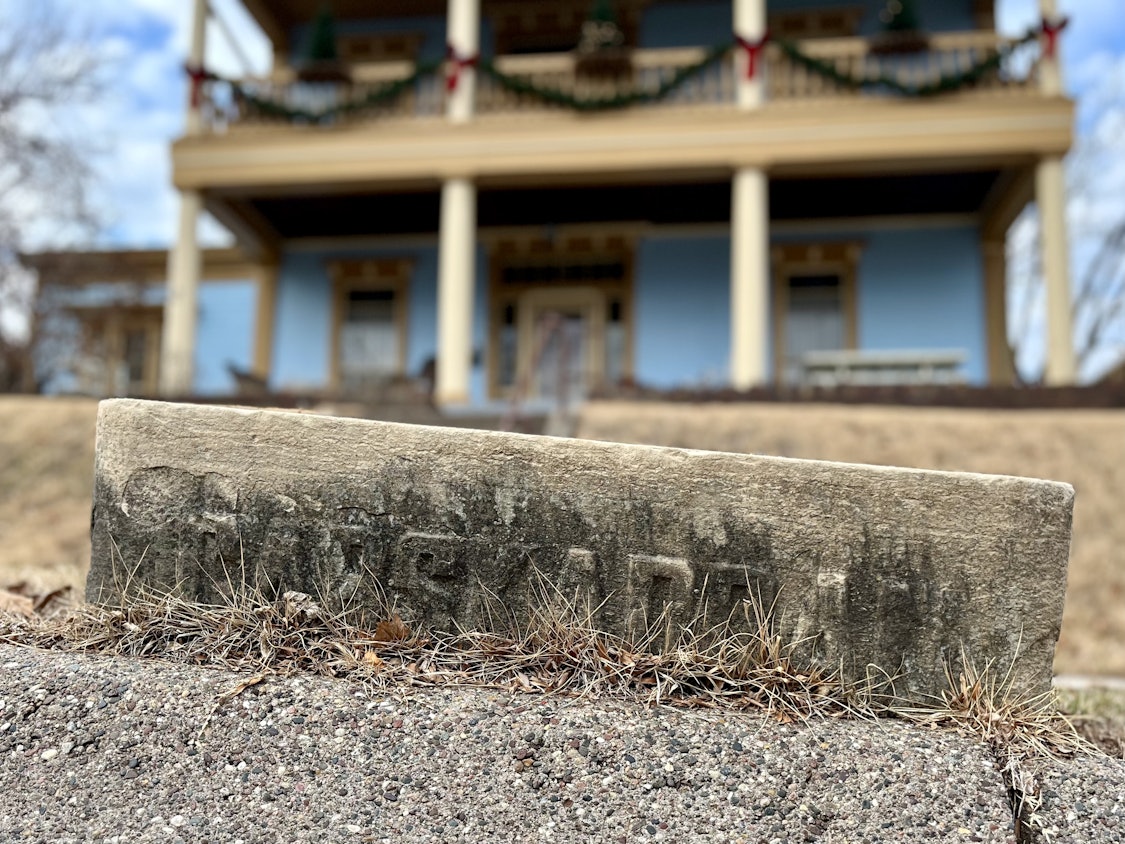
The carriage step in front of the Couch-Carskaddan house in Muscatine’s West Hill Historic District
This column by Daniel G. Clark about Alexander Clark (1826-1891) first appeared in the Muscatine Journal on May 10, 2023.
May is Preservation Month, when we celebrate historic places and ponder the importance of remembering.
I lived in Muscatine almost 20 years before I paid attention to our historic homes—beyond admiration, I mean.
“Lumber barons built these mansions. Aren’t they grand?”
In 2001, I reported the startup of the city’s first Historic Preservation Commission. At the commission I heard of historic stuff that could have been saved if people had known or cared before it was too late—before neglected structures got derided as eyesores or obstacles to progress. Not every old building can be saved or should be saved, they said. Documenting what we have is the first step toward mobilizing resources to be able to save any of them.
I enjoyed interviewing Kent Sissel who served as the only “certified professional” member. Restoration of the historic Alexander Clark House was among his accomplishments.
With his guidance the commission gained necessary training and certification and began making systematic inventories of historic properties.
I got hooked. Leaving the newspaper, I jumped into local history for tourism promotion. I got a trolley bus and started giving tours and telling stories, especially the Alexander Clark story about the local court case that ended segregated education in Iowa.
“Connect the dots,” Sissel always said. “The early settlers all knew each other, you know.”
From the survey report on one of my favorite trolley stops: “This c.1846 Greek Revival house follows the classical format of a two-story, three-bay, symmetrical, central passage house. … The porch features simple Doric columns on both stories, with a later turned railing on the second story. … The house currently retains good integrity from the late 19th Century and the early 20th Century when Jerome D. Carskaddan was residing here. In addition, the historic modifications between 1919 and 1928 were made by his descendent, Jerome Bishop, who has significant ties to the button industry.”
That’s typical of descriptions you can find for many properties via Musser Public Library’s online research link. Go to “Local History & Genealogy,” then “History of Buildings and Neighborhoods of Muscatine.” You’ll find the commission’s survey forms and reports and nominations of historic districts.
So, let’s connect Carskaddan dots. I told tourists Jerome Carskaddan was an important lawyer and judge who served as one of the Clarks’ attorneys for the desegregation case.
“From 1863 to 1879, he was partners with judge De Witt C. Richman as Richman and Carskaddan, this being regarded as one of the strongest law firms of eastern Iowa until its dissolution through the election of Mr. Richman to the circuit bench.”
I’d paid more attention to Richman until February this year when Paul Finkelman invited me forward following his Alexander Clark lecture to answer a question about Clark’s lawyers. I cringe as I watch video and see myself talk about Henry O’Connor who became Iowa’s attorney general, then about Carskaddan’s partner D.C. Richman, then meander off into a chuckle about Richman’s brother D. Scott Richman having been the district court judge who affirmed Susan Clark’s right to attend the local grammar school. Then I stop.
Happily, Kent Sissel was in the audience and called out the Carskaddan name. Jerome was Clark’s longtime personal lawyer, he said, and added that you can still see the family name on the carriage-step stone in front of the 1846 house.
Next came this Facebook comment from a Laura Bishop: “I watched the Alexander Clark Lecture via zoom. It was very informative and interesting. My great great grandfather Jerome Carskaddan was Alexander Clark’s attorney. I have been researching Jerome’s law career in Muscatine and his involvement with Alexander Clark. I would be happy to talk to anyone interested in learning more about Jerome.”
Two weeks later I attended Bob Campagna’s talk about the Clark House apartments built on the historic Clark home site. Afterward [a fellow attender] handed me papers from her Colorado cousin Laura, including Jerome’s 1853-1854 letters to his future bride back in upstate New York.
Speaking by phone and following with email, I learned Laura has done much research and wants to write a Jerome Carskaddan biography.
“I am enclosing the hand-written court documents I received from the law library in Des Moines,” she wrote. Documents that would become the stuff of the landmark ruling, in pages of Jerome’s own handwriting, evidently. Something grand, indeed!
Lawyer, judge, editor, banker, businessman, and—not least—founder and leader of Iowa’s Republican Party. Laura’s ancestor is another local hero to rediscover and celebrate.
* * *
Muscatine Evening Journal, Dec. 13, 1859: “There was a real jam in Tremont Hall last evening to hear Mr. Carskaddan’s lecture. … [His] allusion to the hanging of an old man in our country for attempting to liberate slaves…brought forth a response from the audience which showed plainly their condemnation of the present policy of our government.”
That old man, John Brown, was executed December 2.
Next time: Every thread was a prayer
